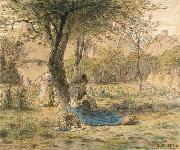
|
Jean-Franc Millet
|
|||
|
|
|||
| French Realist Painter, 1814-1875 | |||
|
|
|||
|
In the garden Jean-Franc Millet14.jpg Painting ID:: 10564 |
1862Watercolour 12.5 x 14.4 inches | ||
|
|
|||
|
Nicolae Grigorescu
|
|||
|
|
|||
| Romanian Painter, 1838-1907 From 1848 he trained in Bucharest with various church painters, producing icons and religious mural decorations. These works, which soon attracted attention, were influenced in style by the Viennese classicism widespread in the Romanian principalities in the early 19th century and by the Italian academicism established there after 1850 by Gheorghe Tattarescu. The earliest of his known paintings are in the church of SS Constantin and Elena at Baicoi, where his signature can be seen beside that of Nita Pereescu on the icon of St George (1853). He subsequently painted a series of icons (1854-5) at Caldarusani Monastery. In the later ensembles he was assisted by his older brother Georghe Grigorescu, who participated under his direction in the decoration of churches, such as those of the Zamfira (1856-8) and Agapia (1858-60) monasteries. In Nicolae's paintings at Agapia, classicism in Romanian art reached its highest point. The royal icons are distinguished for the elegance of the figures, both in their attitudes and in their drapery. | |||
|
|
|||
|
In the Garden new4/Nicolae Grigorescu-899832.jpg Painting ID:: 30766 |
nn06 oil on canvas 23.5x14cm National Art Museum of Romania, Bucharest | ||
|
|
|||
|
Fritz von Uhde
|
|||
|
|
|||
| German, 1848-1911 was a German painter of genre and religious subjects. His style lay between Realism and .Uhde was born in Wolkenburg, Saxony. In 1866 he was admitted to the Academy of Fine Arts in Dresden, but later that year he left his studies for military service, and from 1867 to 1877 he was a professor of horsemanship to the regiment of the assembled guard. He moved to Munich in 1877 to attend the Academy of Fine Arts. In Munich he particularly admired the Dutch old masters, and in 1879 he travelled to Paris where his studies of the Dutch painters continued under Mihely Munkecsy's supervision. In 1882 a journey to Holland brought about a change in his style, as he abandoned the dark chiaroscuro he had learned in Munich in favor of a colorism informed by the works of the French Impressionists. His work was often rejected by the official art criticism, and by the public, because his representations of ordinary scenes were considered vulagar or ugly. The critic Otto Julius Bierbaum was more sympathetic; in 1893, he wrote, "As a painter of children, for example, Uhde is extraordinarily distinguished. He does not depict them as sweetly as used to be popular; in other words not as amusing or charming dolls, but with extreme, very strict naturalness." In about 1890, Uhde became a professor at the Academy of Fine Arts in Munich. | |||
|
|
|||
|
In the Garden new9/Fritz von Uhde-954924.jpg Painting ID:: 34026 |
mk87 1906 Oil on canvas 70x100cm Mannheim,Stadtische Kunsthalle Mannheim | ||
|
|
|||
|
Henry John Yeend King
|
|||
|
|
|||
| an important Victorian genre and landscape artist . English,1855-1924 | |||
|
|
|||
|
In the Garden new10/Henry John Yeend King-234843.jpg Painting ID:: 34749 |
|||
|
|
|||
|
Fritz von Uhde
|
|||
|
|
|||
| German, 1848-1911 was a German painter of genre and religious subjects. His style lay between Realism and .Uhde was born in Wolkenburg, Saxony. In 1866 he was admitted to the Academy of Fine Arts in Dresden, but later that year he left his studies for military service, and from 1867 to 1877 he was a professor of horsemanship to the regiment of the assembled guard. He moved to Munich in 1877 to attend the Academy of Fine Arts. In Munich he particularly admired the Dutch old masters, and in 1879 he travelled to Paris where his studies of the Dutch painters continued under Mihely Munkecsy's supervision. In 1882 a journey to Holland brought about a change in his style, as he abandoned the dark chiaroscuro he had learned in Munich in favor of a colorism informed by the works of the French Impressionists. His work was often rejected by the official art criticism, and by the public, because his representations of ordinary scenes were considered vulagar or ugly. The critic Otto Julius Bierbaum was more sympathetic; in 1893, he wrote, "As a painter of children, for example, Uhde is extraordinarily distinguished. He does not depict them as sweetly as used to be popular; in other words not as amusing or charming dolls, but with extreme, very strict naturalness." In about 1890, Uhde became a professor at the Academy of Fine Arts in Munich. | |||
|
|
|||
|
In the Garden new19/Fritz von Uhde-726976.jpg Painting ID:: 54325 |
mk235 1906 Oil on canvas 70x100cm | ||
|
|
|||
|
Also Buy::. For Following Paintings / Artists / Products, Please Use Our Search Online: |












